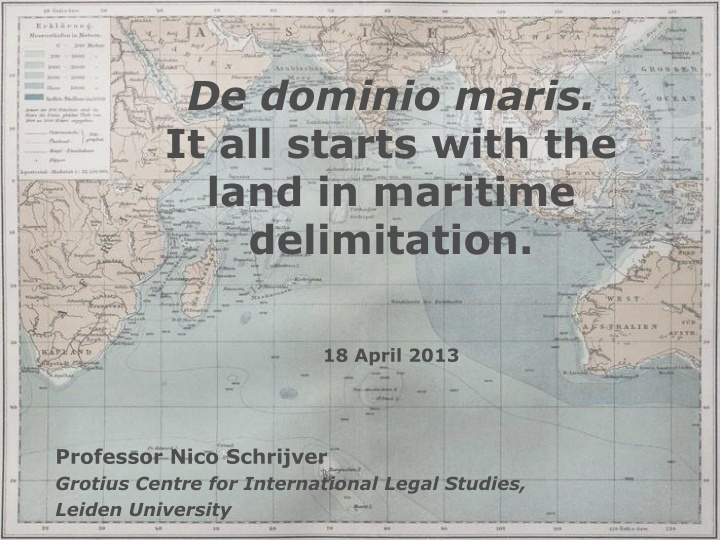



De dominio maris. It all starts with the land in maritime delimitation. 18 April 2013 Professor Nico Schrijver Grotius Centre for International Legal Studies, Leiden University
Islands are a full and integral part of the land territory of a state • Naturally formed area of land, surrounded by water, which is above water at high tide. (art. 121(1)) • “Islands, regardless of their size, in this respect enjoy the same status, and therefore generate the same maritime rights, as other land territory,” (ICJ, Qatar/Bahrain, § 185)
Title to territory remains the starting point of any maritime delimitation • Original title as part of ancient territorial domains • Treaty title • Title based upon judicial or arbitral decisions • In absence of title: effective manifestation of sovereign authority
Original Title • no terra incognita and no terra nullius • Ligitan/Sipadan (2002): insufficient evidence of ties between the islands and the Sultanate of Sulu • Malaysia/Singapore (2008): islands had been part of the territory of the Sultanate of Johor • Dokdo/Takeshima : territorial domain of ancient Korean kingdoms? • Diaoyu / Senkaku : part of the Ming (1368-1644) and Qing (1644-1912) dynasties?
Map of East China Sea
Treaty Title • Qatar v. Bahrain (2001): Hawar Islands (Bahrain) and Janan Island (Qatar) • Ligitan/Sipadan (2002): 1891 Anglo-Dutch Convention? • Nicaragua v. Colombia (2012): 1928 Treaty on Territorial Questions • Dokdo/Takeshima : San Francisco Peace Treaty, 1951? • Diaoyu / Senkaku : Treaty of Shimonoseli, 1895 - unequal treaty?
Effective Manifestation of Sovereign Authority • Frontier Dispute. Burkina Faso/Mali , 1986 • Qatar v. Bahrain (2001): only relating to islets • Indonesia/Malaysia (2002): effectivités as the only basis of attribution of sovereignty • Nicaragua v. Honduras (2007) • Nicaragua v. Colombia (2012) • Dokdo/Takeshima : Does Korea have the “superior claim”? • Diaoyu / Senkaku : peaceful administration and variety of activities by Japan?
Passing of sovereignty by tacit agreement arising from parties’ conduct • Actual conduct à titre de souverain may result in transfer of sovereignty • Island of Palmas (1928): “concrete manifestations of the display of territorial sovereignty by the other State” • Ligitan/Sipadan (2002): no protest against Malaysian acts of sovereignty until critical date of dispute • Malaysia/Singapore (2008): Horsburgh lighthouse 1844, 1953 letters, Singapore’s acts after 1953 • Dokdo/Takeshima : ‘Japan has nothing to do with them’ (1877)
Role of Islands in the Maritime Delimitation Process • Islands belong to the land territory and generate maritime rights • Not every maritime feature • Three stages in which islands play role in maritime delimitation: – Identification of relevant coasts; – Selection of base points; – Adjustment of provisional delimitation line
De dominio maris. Thank you for your attention!
Recommend
More recommend